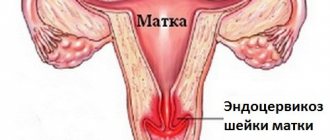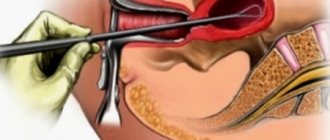What is electroexcision of the cervix?
This operation involves the removal of damaged cervical tissue. With this excision, the removed area remains suitable for further research. For excision of the cervix, a device with electrosurgical equipment is used. The advantage of this method is that when removing the epithelium, the incisions are made with virtually no blood loss. The current immediately coagulates the cut. Thus, the remote area is suitable for further research.
One of the methods of electroexcision (diathermoexcision) is loop excision. This is the excision of the affected area using a live wire, which has the shape of a circle, triangle or square. A piece of the cervix is excised and also submitted for further examination.
https://youtu.be/cCiTgFyapeI
Where to have cervical conization done in Moscow?
The ART programs in which our center specializes are a knowledge-intensive field of medicine. All gynecological operations at Life Line are carried out using high technology in accordance with current international standards.
- The decision on the need for conization is made by an experienced gynecologist on an individual basis, based on the results of a comprehensive examination
- The operation is performed by doctors with many years of experience in gynecological surgery, who regularly improve their level at conferences, workshops and seminars
- Qualified observation after conization reduces the risk of negative consequences to zero
In what cases is electroexcision of the cervix prescribed?
This operation is prescribed for various pathologies that cannot be cured with medication. The most common conditions that should be treated with electroexcision are:
- Dysplasia. This is the next stage after cervical erosion, which affects the epithelium of the cervix and looks like a white coating on the tissue. Usually the affected area is cut off so that the pathology does not spread over the entire surface.
- Malignant formations. Unlike other methods of surgical intervention, this method is suitable even in cases where preliminary diagnosis has determined the presence of cancer cells. Only the doctor will decide how appropriate this method will be. If the malignant tumor is not large, it will be removed using electroexcision, and then drug or radiation treatment will be used.
- Scarring. After various manipulations, scars may remain on the cervix. If a woman plans to have children in the future, scarring of the cervical tissue is completely inappropriate for her. Therefore, using electroexcision, doctors can remove scarred tissue.
- The formations on the cervix are benign. These can be polyps, condylomas, papillomas, etc. They are removed using loop electroexcision.
- Cervical erosion can also be treated with electroexcision. However, if a girl has slight erosion, then you can think about other more gentle methods. For example, laser cauterization.
Contraindications for surgery
Despite the fact that this operation allows you to eliminate a huge number of problems associated with the cervix, electroexcision has a number of contraindications.
- Genital tract infections. These inflammations can be in both acute and chronic forms. In any case, you cannot start electrical excision until the inflammation is eliminated. Otherwise, the risk of severe complications is enormous.
- Bleeding of unknown etiology is an absolute contraindication to manipulation of the cervix.
- Menstruation.
- Pregnancy and breastfeeding do not allow cervical surgery. Before starting the procedure, the woman must take a pregnancy test.
How is the rehabilitation period going?
In most cases, the postoperative stage passes without any serious complications. Women remain under the supervision of medical personnel for several hours, after which they are sent home.
During the day, they may experience painful sensations in the lower part of the peritoneum, which can be relieved with any anti-inflammatory non-steroidal drug. For example, Paracetamol or Ibuprofen tablets.
During surgery, a fibrin film is applied to the cervix, which is rejected by the organ after 5 days. During this time period, spotting of a brownish tint may be observed.
Psychological causes of endometriosis and associated pathologies Effective treatment of uterine endometriosis Pain in the lower abdomen due to thrush Candidiasis does not go away after treatment - what to do
After 10 days, complete healing will occur, but scanty discharge may continue for 20 days.
If the patient’s temperature rises or the discharge becomes foamy or purulent, you should consult a doctor, as a complication has most likely begun.
How to prepare for the procedure?
Training is divided into medical and independent. During medical training, a woman must undergo a course of diagnostics and all kinds of tests to detect contraindications.
- Analyzes. To begin with, a woman donates her blood and urine for testing. Next, the gynecologist takes material from the vagina, which includes a regular smear for cleanliness. Next, the biomaterial is examined for the presence of atypical cells.
- Research on equipment. Ultrasound. Diagnostics of internal organs is carried out for the presence of pathologies and inflammations. The doctor also uses a colposcope to make an accurate diagnosis.
- Before electroexcision, you should make sure that the woman does not suffer from various sexually transmitted diseases, for example, gonorrhea, syphilis, chlamydia, and so on. If any inflammation is detected, the operation is postponed until the woman is completely cured. After treatment, re-diagnosis is performed.
Immediately before the operation, the patient must follow several self-preparation rules:
- Give up sexual intercourse for a week;
- The evening before electroexcision, eat a light dinner;
- Sutra it is better not to eat anything;
- Carry out genital hygiene, but without using fragrances and fragrances.
Procedure for electroexcision
The doctor must provide moral support to the patient during this procedure. He will tell her what he is going to do and how it will make her feel. Then it begins to act according to plan:
- A passive electrode is attached to the surface of the thigh.
- A gynecological speculum, which does not conduct current, is inserted. If there is none, then the metal mirror should be placed in a latex condom.
- Using a colposcope, the affected area of the cervix is determined. Treat it with vinegar solution or iodine. This way the doctor will see clear boundaries of the lesion.
- The woman is given anesthesia using a long needle. Due to this, the operation is painless for her.
- The doctor then prepares the excision apparatus. It would be better to choose an electrode that will immediately cover the entire affected area. If the girl has not given birth, then the maximum expansion of the electrode will be 0.5 cm. If the patient has given birth, then the expansion will be 0.8 cm.
- Then the excision itself occurs, with the smoke evacuator previously turned on.
- The excised material is placed in a container and sent for further examination for atypical cells. The operation itself lasts from 10-30 minutes.
An approximate image of electrical excision of the cervix is shown below.
How is loop excision of the cervix performed?
The procedure is performed under local anesthesia. The doctor performs a colposcopy and determines the boundaries of the lesion, according to which the shape and size of the wire loop - the active electrode - are selected. A passive electrode is attached under the buttocks or on the thigh of the patient, and the power of the equipment is adjusted. The changed area is deleted one or more times. Then coagulation of the bleeding vessels is carried out with a spherical electrode. In the presence of a high degree of damage and pathological changes in the epithelium in the cervical canal, endocervical curettage is performed.
Recovery period
After electroexcision, the recovery period varies depending on what disease was treated and the degree of epithelial damage. During healing, you may experience pain in the lower abdomen. It can be eliminated with Ibuprofen and Paracetamol. Minor bleeding is also possible, which can last up to a month. In this regard, you should follow some rules and recommendations:
- Do not use tampons;
- Do not swim in ponds or bathtubs;
- Refrain from sexual intercourse;
- Do not lift heavy objects.
All this should be done within a month. Afterwards, the woman needs to come for an examination so that the doctor can evaluate the healing process of the cervix. Also at this appointment, the gynecologist will tell you the result of a histological examination of the tissue.
Postoperative period: norm and pathology
In the first days after radio wave conization of the cervix, there is sanguineous discharge from the genital tract. Gradually, the volume of discharge decreases, and by the third week it completely disappears. A specific odor may appear from the discharge - not too strong, but unpleasant. By the end of the first month after surgery, all discharge should completely stop.
Nagging pain in the lower abdomen may occur directly during the procedure, as well as during the first week after surgery. The pain is mild, localized above the pubis in the center, and is not accompanied by a significant deterioration of the condition. If you don’t want to endure pain, you can take No-shpa or Nurofen (no more than 3 days in a row).
Radioconization of the cervix does not have a significant effect on the menstrual cycle, and most women have their periods on time. There may be a slight delay of up to 3-5 days. According to reviews, the first periods may be heavy and painful, but later the cycle is completely restored.
As a rule, the menstrual cycle after the radioconization procedure of the cervix resumes on time.
The general condition after surgery is usually satisfactory. Some women note an increase in body temperature to 37-37.5 °C. The temperature lasts no more than three days; antipyretics are not prescribed.
Moderate nagging pain in the lower abdomen, sanguineous vaginal discharge and a slight delay in menstruation are normal after conization.
Warning symptoms to look out for:
- Continuous or increasing bleeding from the genital tract (profuse, with clots);
- Severe pain in the lower abdomen;
- Increased body temperature more than 37.5 °C;
- The appearance of purulent discharge;
- Copious discharge with an unpleasant odor 3 weeks after surgery;
- Delay of menstruation for more than 7 days.
All these symptoms indicate the possible development of complications and require mandatory consultation with a doctor.
A follow-up examination by a doctor after conization is carried out after 2 weeks, colposcopy - after 4-6 months. If the examination results are good, the woman should visit the doctor every 6 months or more often if indicated.
Possible complications
Below is a list of possible complications and options for eliminating them.
- Bleeding, which can be either diffuse or arterial. If bleeding after electroexcision is diffuse, it is eliminated using coagulation with an electrode. If the bleeding is arterial in nature, then it is stopped using a spherical device.
- If bleeding begins immediately after surgery, begin rinsing the vagina with a vinegar solution to remove the clot.
- In rare cases, after electroexcision, inflammatory processes are observed, which manifest themselves in the form of fever, purulent discharge, and pain. In this case, the doctor will prescribe antimicrobial drugs such as Cefixime, Dixycycline, Metronidazole.
All these consequences are observed in only 2% of all women who have undergone this surgical intervention.
Is pregnancy possible after electroexcision?
In some cases, removal of damaged cervical epithelium may result in scarring. Or another difficulty is the large area of the removed area of the cervix.
In these cases, complications during pregnancy and childbirth are possible. Often, women are offered a caesarean section after cervical excision. The reason is that the cervix may either not open or be damaged during childbirth.
Another complication after electroexcision is premature pregnancy. Premature birth is a common occurrence after cervical manipulation.
Therefore, those girls who want to have children should consider, if possible, another method of cervical treatment. Laser conization is ideal.
Undesirable consequences and complications
Conization of the cervix using the radio wave method can lead to the development of the following complications:
- Bleeding is an extremely rare complication, since the vessels coagulate immediately after the incision (1-2% of cases);
- Wound infection – occurs when personal hygiene rules are not observed or in the presence of chronic cervicitis at the time of surgery (1-2%).
Following the rules of personal hygiene will help to avoid various infectious complications after surgery.
If for some reason conization was carried out repeatedly, the risk of the following complications increases:
- Scarring of the cervix;
- Cervical canal stenosis.
The use of modern techniques makes it possible to reduce the likelihood of such consequences to almost zero.
Price
The price of this operation directly depends on the clinic where this procedure will be performed. Below are three centers in St. Petersburg.
| Medical Center | Price |
| Honey. | 6500 rub. |
| Orkley Hospital | 15300 rub. |
| Honey. Abia center | 6300 rub. |
So, the method of electroexcision of the cervix copes well with various pathologies and changes in the epithelial layer. The procedure is performed under anesthesia, so the patient feels almost no pain. However, if the girl has not yet given birth, then, if possible, she will be offered another type of elimination of the pathology.







